Corpse paint
Le corpse paint (littéralement : peinture de cadavre) est un type de maquillage noir et blanc peint autour des yeux et sur les lèvres, artifice très utilisé par les groupes de black metal pour accentuer leurs expressions et se donner une apparence inhumaine, cadavérique ou démoniaque[1] - [2] - [3].
Le corpse paint est initié par Arthur Brown, chanteur rock britannique, pour sa chanson Fire, à la fin des années 1960 ; Alice Cooper, au début des années 1970, reprend ce style puis est suivi par des groupes de heavy metal, comme King Diamond de Mercyful Fate ; le groupe de metal extrême brésilien Sarcófago, l'un des premiers de l'histoire au Brésil, en fait usage, influençant notamment le guitariste Euronymous du groupe Mayhem[4] et bientôt toute la deuxième vague de black metal. D'autres groupes, par exemple Antestor, groupe de unblack metal, l'utilisent au même titre que le maquillage de pantomime[5] et, certains, comme marque de défiance à la société : « Corpse paint is an attempt by black metallers to look grim and necro and to show their defiance for religion and authority[6]. »
Le corpse paint a aussi inspiré certains rappeurs, pratiquant un sous-genre du hip-hop, appelé horrorcore. L'exemple le plus connu est sans doute Insane Clown Posse, un groupe relativement célèbre aux États-Unis, mais peu connu en Europe, où horrorcore est représenté par Visceral records, premier label horrorcore français avec différents groupes tels que Mordom et Redrum.
- Divers corpse paints
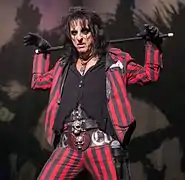
_singing_close-up.jpg.webp)
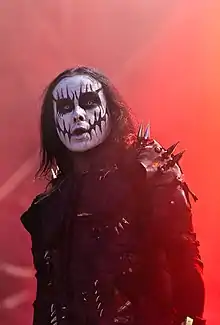
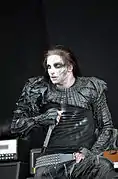
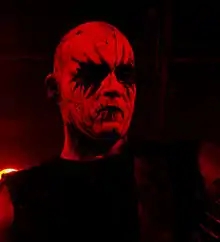
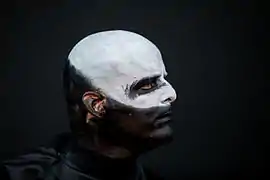
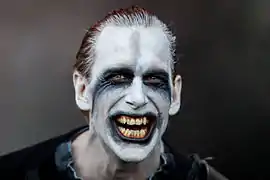
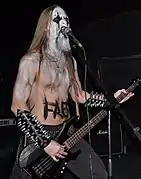
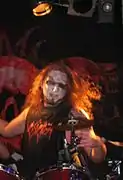
Références
- (en) Ronald Bogue, Deleuze's Way: Essays in Transverse Ethics and Aesthetics, Ashgate Publishing Limited, (ISBN 9780754660323, lire en ligne), p. 45 :
« Many black metal musicians dress in black robes and wear exaggerated white-and-black corpsepaint on their faces »
- (en) Joel McIver, Machine Head: Inside the Machine, Omnibus Press, (ISBN 9780857127983, lire en ligne) :
« You get kids over there in corpsepaint going to a death metal show, but then are going to go to [a] Darkness show. »
- (en) Donna Weston et Andy Bennett, Pop Pagans: Paganism and Popular Music, Routledge, (ISBN 9781317546658, lire en ligne) :
« Far more Pagan metal bands appear in the traditional black metal corpsepaint »
- http://www.metalunderground.com/news/details.cfm?newsid=96433
- (en) « Antestor: turskamusiikkia turskain luvatusta maasta », The Christian Underground Zine, Stockholm, The Christian Underground ry., vol. 4, 24 - 26 mars 2000 :
« Interviewer: « What's your relation to penguin masks? Do you use them on your concerts? »
Antestor: « Until now we haven't done many gigs, so the answer would be no. On the other hand today (at Bobfest) we all are going to paint our faces for the first time, so yes, we use masks. It is the same for us as masking is for actors or mimes. One way to express certain feelings in the battle we are in. The main purpose is to concentrate on God and not to twist the knife in the wound in side issues like these. » » - (en) scskowron, « On the Role of Clothing Styles In The Development of Metal - Part I », sur metalstorm.net, (consulté le )